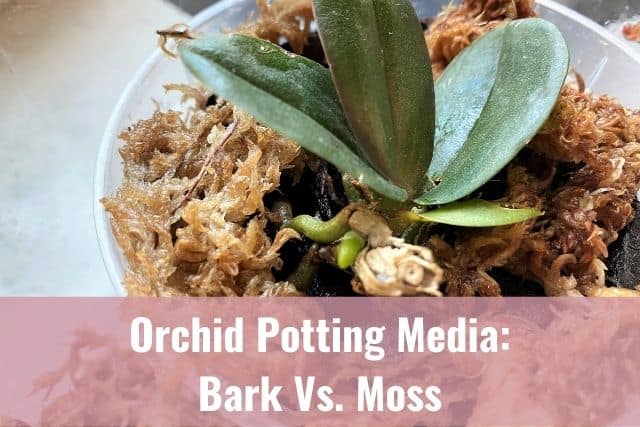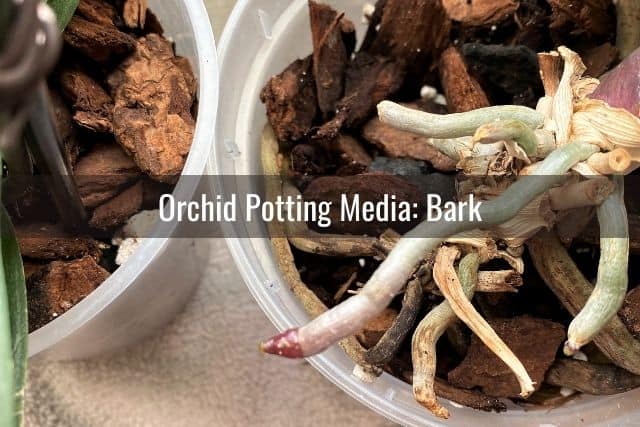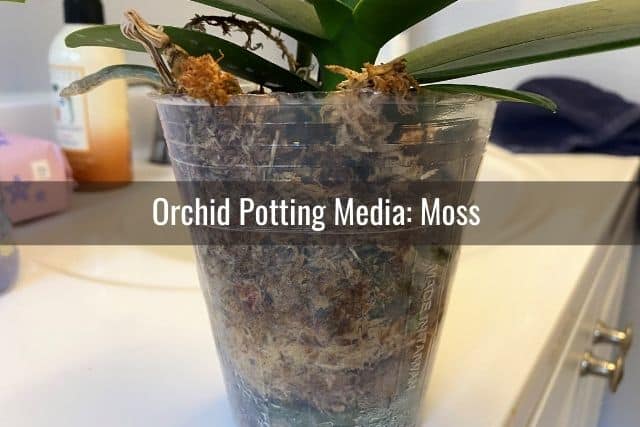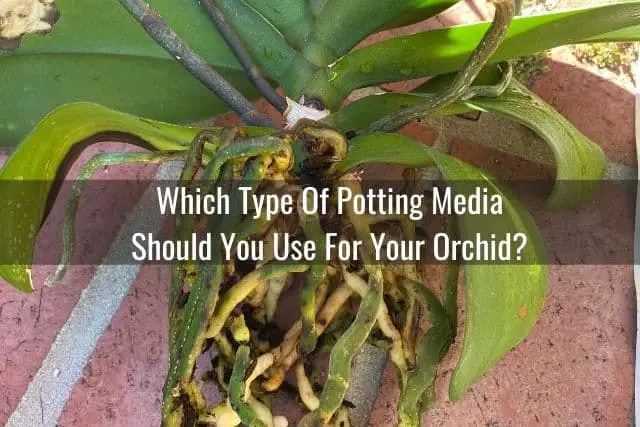Repotting an orchid is an annual or biannual task that every orchid grower needs to do. However, when it comes time to buy a new orchid potting media, how do you decide what to use? Bark or moss? There are so many different options out there, from fine-grade bark mix to coarse bark mix to moss. You can also use a custom orchid potting mix or use an alternative potting method.
Deciding which type of orchid potting media to use often boils down to personal preference and the type of orchid involved. Certain types of orchid potting media are designed to work better for one species over another. This is due to each orchid’s unique care needs, in particular its watering and humidity needs.

With so many possibilities, it is important that you buy the right potting mix for your orchid. In this article, I’ll take a deeper look into the differences between two popular types of orchid potting media, bark and moss. I’ll go over the pros and cons of each. I’ll also give you some recommendations about which potting media to use for certain situations and orchid types. Keep reading to learn more.
Please note that these links are affiliate links and as an Amazon Associate, I earn from qualifying purchases. Purchases made through affiliate links in this post may generate commissions at no additional cost to you. Use this link for a discounted Amazon Prime trial. Thank you for your support!
Table of Contents
Orchid Potting Media Options
Which is the best orchid potting mix to use when you repot your orchid? If you are preparing to repot your orchid, this question will likely come up at some point. After all, there is a wide selection of different types of orchid potting media available for purchase.
Two of the more common orchid potting mix options include bark-based orchid potting media and sphagnum moss. Even within the bark-based potting media options, there is fine-grade, medium-grade, and coarse bark. How do you possibly choose with all these options available? I will go into more detail about each of these, along with the pros and cons, in more detail below.
Other potting media options include lava rock, gel beads, and hydroponics. These are less often used, alternative potting media options that are available for your orchid. You can also opt to mount your orchid to a tree, wood board, or cork, instead of potting it. You can read more about alternative orchid potting media options here.
Orchid Potting Media: Bark

Bark-based orchid potting media is probably the most commonly used potting media when repotting orchids. This is in part because bark works so well for thick-rooted Phalaenopsis orchids, the most popular orchid species sold out on the market.
Phalaenopsis orchids are frequently given as gifts, bought to grace office entrances or decorate homes. These plants are a great introductory orchid for new or beginner orchid growers.
If you are new to orchid growing, I recommend potting your Phalaenopsis orchids and other thick-rooted orchid species in a bark-based potting media.
Pros To Using Bark As An Orchid Potting Media
There are several benefits to using a bark-based potting media for your orchid. These include better drainage and air circulation, when compared to moss. It is also easier to tell when your orchid needs water when it is potted in bark. Let’s go over these benefits in more detail.
Better Drainage
One of the biggest benefits to using bark-based potting media is better drainage. This is especially true when you compare bark to sphagnum moss. The inherent shape of the bark chips allows water to rapidly drain from the pot after each watering. This is important to know, especially if you tend to overwater your plants.
While a bark-based potting media won’t prevent root rot from occurring, it does minimize how long water remains in the orchid pot.
Air Circulation
Another benefit to using a bark-based potting media is air flow. The bulky shape of the bark pieces naturally creates gaps within the potting media. This allows for some degree of air flow and circulation inside the pot and between the roots.
Air movement is essential for epiphyte orchids such as Phalaenopsis orchids. Air flow helps the water evaporate more quickly and prevents mold and rot from taking hold. Adequate air movement contributes to the overall health of the orchid roots.
Easier To Manage Watering Frequency
In general, I recommend that beginner orchid growers pot their orchids in bark-based potting media rather than moss. This is especially true if you are just getting used to the nuances of watering an orchid.
When an orchid is potted in bark-based media, it is easier to tell if your orchid needs to be watered. Simply insert a chopstick or pencil end a few inches down into the potting media. This lets you know see how wet or dry the potting media is. Based on the results, you can decide to water or not.
This is unlike sphagnum moss, which tends to dry out unevenly. Moss dries out at the tops and outer edges first. Meanwhile, the innermost areas of the pot remain damp and moist. Unfortunately you won’t be able to see this and you can easily end up overwatering an orchid potted in moss. You don’t have this issue as much with orchids potted in bark.
Be sure to read more about how to water an orchid here and how to water an orchid potted in moss on Everyday Orchids. Please note that there are two different watering guides based on the two very different potting mediums used.
Cons To Potting An Orchid In Bark
While there are several benefits to using a bark-based media, there are several drawbacks as well. Let’s go over those next.
Root Rot Is Still Possible
Keep in mind that orchids potted in bark-based media can still succumb to overwatering and develop root rot. While you have faster drainage with a bark-based media, the bark can still remain damp for extended periods of time. If you tend to overwater, the bark won’t have a chance to dry out. Over time, the roots will slowly rot and die.
Risk For Dried, Shriveled Roots
On the other hand, if you don’t water your orchids often enough, you can end up with dried, shriveled roots.
Bark does not retain water as well as moss, so it is important to be regular with watering frequency, not too often or too little. Otherwise, if you infrequently water your orchid, chances are high that some of the roots will begin to dry out.
Honestly though, this can happen with any potting media if you don’t water your orchid often enough.
Bark Decomposes Over Time
Another drawback to using bark-based potting media is that it degrades and decomposes over time. On average, orchids potted in bark will need to be repotted every one to two years.
Be aware that the more frequently you water an orchid, the faster the bark will break down. As bark-based potting media decomposes, it starts to break down into smaller pieces. This leads to slower drainage and decreased aeration. The end result is an increased risk for root rot.
Bark As A Home For Orchid Pests, Mold And Disease
Decomposing bark-based potting media can be a home to orchid pests such as fungus gnats. These are tiny flies that are notoriously hard to get rid of.
If you find fungus gnats around your orchid, you likely have eggs and larvae hiding in the potting media as well. Repotting your orchid will be necessary. You can read more about how to get rid of fungus gnats here.
Overwatered bark can also lead to mold and fungal growth within the potting media. This will obviously affect the orchid’s root health.
Mold and fungus in left to grow in bark-based potting media leads to root rot, stunted growth, and disease. In this case, the potting mix cannot be salvaged and repotting your orchid with new potting media will be necessary.
Orchid Potting Media: Moss

So, I’ve gone over the pros and cons of using a bark-based orchid potting media above. Next, let’s talk about sphagnum moss. While some orchid growers would not pick moss for an orchid potting media, it still commonly used by others.
If you have an orchid planted in sphagnum moss, read this article on how to water an orchid potted in moss. The watering technique and frequency will be different for an orchid potted in moss compared to an orchid in bark-based media.
Sphagnum moss is commonly used for growing keiki orchids. It is also used when propagating new orchids. Orchid growers who are producing and selling orchids in mass also pot their orchids in sphagnum moss. For this reason, many orchids that are sold in the grocery stores or orchid warehouses are potted in moss. Therefore, it is important to know the pros and cons of using moss as a potting media for your orchids.
Pros To Using Moss As An Orchid Potting Media
Some orchid growers prefer to use sphagnum moss when repotting their orchids. There are a few clear benefits to using moss as a potting medium, which I’ll explain below.
Water Less Frequently
One of the biggest benefits to using sphagnum moss is that you don’t need to water your orchid as often. Sphagnum moss is naturally more water-retentive. It can hold moisture longer than other types of orchid potting media.
I have orchids potted in bark-based media as well as orchids potted in sphagnum moss. On average, I water my orchids in bark once a week (or twice a week, depending on the season and weather). In contrast, I water my orchids potted in moss once every two weeks on average.
If you are a busy orchid grower, less frequent watering is definitely a huge benefit to using sphagnum moss.
Costs Less Than Bark
Another benefit to using sphagnum moss as an orchid potting media is that moss is relatively inexpensive. It is always sold dried and will expand to many times its weight once it is soaked in water. A little moss will go a long way.
A 1-pound bag of bark-based orchid mix may be just enough for repotting two or three orchids. However, a 1-pound bale of sphagnum moss could potentially be used to repot a dozen orchids of varying sizes.
Less Risk For Diseases And Pests
Since sphagnum moss is sold dried, there are less chances of it harboring mold or pests.
This is unlike bark-based potting mix. Bark-based potting mix starts to breaks down when exposed to heat and moisture. It can even start to decompose or mold while in a sealed bag at the store. Sometimes, the bag of bark-based mix may already be filled with mold or pests when you first open the bag.
This has happened to me in the past. When I opened the “brand-new” bag of orchid bark, multiple bugs were crawling inside and the bark was white with mold. Obviously, I had to throw it away and buy another new bag. In contrast, this has never happened with a bag of sphagnum moss.
Moss Is Ideal For Certain Orchids And Situations
Keikis, or baby orchid plants, need a lot of moisture and humidity starting out. Sphagnum moss provides this ideal environment for them.
In addition, certain types of orchids, such as high-humidity, moisture-loving orchids like Miltoniopsis orchids, will do better in sphagnum moss.
If you have an orchid with dried, shriveled roots, or an orchid without roots, sphagnum moss is perfect for saving your orchid. Sphagnum moss retains a lot of moisture and helps create a highly humid environment for the orchid. In fact, sphagnum moss was key in helping me quickly grow orchid roots using a humidity box.
Cons To Potting An Orchid In Moss
While there are many benefits to using sphagnum moss as an orchid potting media, there are some drawbacks as well. These drawbacks are the main reason why I would not recommend sphagnum moss for new orchid growers. There is already a learning curve for growing orchids, and figuring out how to water an orchid potted in moss on top of that may prove to be too much for some people.
Retains Moisture For Long Periods Of Time
Moisture retention is one of sphagnum moss’ biggest benefits, but also it’s biggest drawback. When an orchid is potted in moss, the water will take longer to evaporate. The moss will keep the roots wet longer.
Root rot can happen more quickly in an orchid potted in moss.
Unfortunately because the moss in the center of the pot takes the longest to dry out, but the outer moss looks dry, you may end up watering your orchid sooner than needed. As a result, the innermost roots may start to rot. You may not realize the orchid is dying until it is too late.
Sphagnum moss’ ability to retain water is what makes it more difficult to work with for beginner orchid growers. Those used to watering their houseplants several times a week will end up quickly overwatering and killing their orchid.
I’ve found that unlike houseplants, or even orchids potted in bark, which need water at least once a week, orchids potted in moss can go two weeks between waterings. This can take some getting used to for those unfamiliar with this potting medium.
Moss Can Wick Water From The Roots
On the flip side, if you don’t water your orchid often enough, the moss will start to dry out. As it dries out, it might try to absorb moisture from any nearby available source. This includes the roots.
As you can imagine, this is detrimental to the orchid’s root health. You can end up with dried, shriveled orchid roots before you know it.
Issues With Repotting
Another drawback to using moss as a potting medium is that it has a tendency to cling to the orchid roots, especially when it is wet. This can make repotting the orchid more time-consuming. Pieces of moss end up sticking to the roots during repotting. It can be difficult to get all the old moss off without damaging the roots.
If you choose to repot your orchid in sphagnum moss, be sure you wear gloves before handling the moss. Sphagnum moss has little barbs and spikes invisible to the naked eye. These are what helps the moss cling to trees and plants.
Unfortunately, these little barbs and spikes can also pierce the skin on your hands, leading to infection. While wearing gloves is recommended when repotting any plant, it is a must-do when repotting your orchid into sphagnum moss.
Orchid Pot Can Tip Over Easily
Last but not least, sphagnum moss is incredibly lightweight. Orchids tend to be top-heavy. If you are potting your orchid in moss and using a clear plastic pot, you should double-pot your orchid. This will help prevent the orchid from tipping over.
Orchids that fall or tip-over can end up with broken leaves and roots. Even worse, flower spikes can break or snap off your top-heavy orchid, prematurely ending your orchid’s blooming season. Do everything you can to prevent this from happening!
Which Type Of Potting Media Should You Use For Your Orchid?

Now that I’ve laid out the pros and cons of bark-based potting media and sphagnum moss, you might be wondering which potting media is best for your orchid. The answer really depends on two things: personal preference and the type of orchid you have.
Personal Preference
Some orchid growers prefer to pot their orchids in bark-based media, while others prefer sphagnum moss. Still others prefer to use semi-hydroponics using LECA pebbles or mount their orchids on wood boards. It is all a matter of personal preference and what you are most comfortable with.
Many times, an orchid grower will become familiar with one type of potting media and stick with it. This is fine, as long as the orchid’s growing needs are met. This brings us to our next point below.
The Type Of Orchid
An orchid’s species and particular care needs are an important consideration when deciding what type of potting media to use. Certain types of orchid potting mix are better suited for specific types of orchid species.
As I alluded to earlier, thick-rooted orchids, such as Phalaenopsis orchids, tend to do better in bark-based potting media. However, Phalaenopsis orchids can also be successfully grown in sphagnum moss as long as you adjust your watering practices. I personally have Phalaenopsis orchids growing in both types of potting media and they do equally well.
That said, I would still recommend using medium-grade bark-based potting media for Phalaenopsis orchids over moss. This is especially true if you are a beginner orchid grower and not used to the nuances of watering an orchid in moss.
Fine-grade bark mix or sphagnum moss is better for thin-rooted orchids and young orchids. Medium-grade or coarse bark mix is more suitable for older orchids or thick-rooted orchids.
If you have an orchid that requires faster drainage, reach for the coarse-grade bark-based potting media. Coarse-grade potting media is generally a mix of larger bark chunks, charcoal, perlite, and other components. This kind of potting mix allows for rapid drainage and good airflow.
Orchids requiring frequent watering or high humidity, such as Miltoniopsis orchids, do well in sphagnum moss. You can also use a fine-grade bark-based potting media.
Keiki orchids and newly propagated orchids are best potted in sphagnum moss when starting out. Orchids suffering from root loss can also be potted in sphagnum moss to help encourage faster root growth.
Final Thoughts
Hopefully after going through the pros and cons of bark versus moss, you have a better idea of which potting media works best for you and your orchid.
The choice of which kind of orchid potting media to use, bark or moss, boils down to personal preference and your orchid’s care needs.
A bark-based potting media will work better for certain types of orchids, as well as beginner orchid growers. Sphagnum moss is excellent for growing new keiki orchids and saving orchids who have lost their roots. It is also a great option for orchids with high moisture requirements.
I hope this information has helped you. If you are interested in learning more, check out this resource on orchid potting media components. As always, happy orchid growing!
If you enjoyed this article, please pin it and share!





